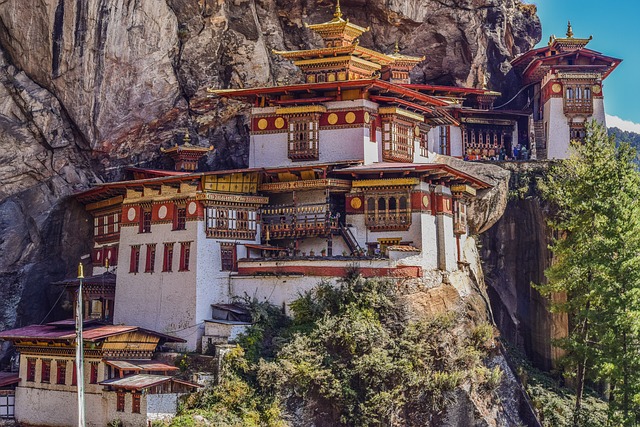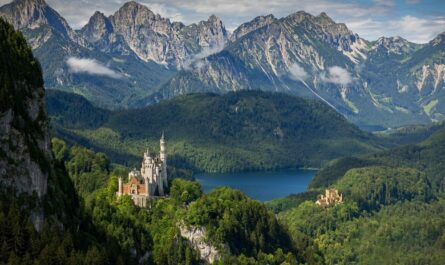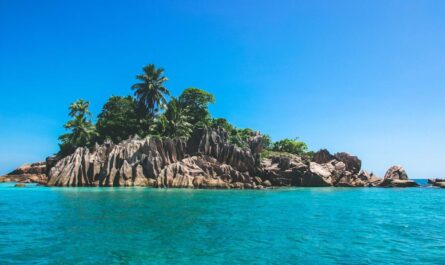How Bhutan preserve their Culture
My trip to Bhutan started like this. I was roving in Kolkata. There I met a Buddhist near Belur Math. veritably impressed to meet him. He was a occupant of Bhutan. He told me a lot about Bhutan. I allowed I might be missing a good spot. perhaps I should visit Bhutan. When my Kolkata stint was over, I left for Bhutan. In this “How Bhutan preserve their Culture ” blog, we will try to know every aspect of Bhutan and I’ll try to inform you of everything according to my traveling experience.
You will get to read all these things in this story.
- Why is Bhutan famous?
- How Bhutan preserve their Culture
- Best time to visit Bhutan?
- Best Food?
- How many days is sufficient for traveling to Bhutan?
- Bhutan Itinerary?
- How can I go to Bhutan?
- Is Bhutan safe for traveling?
- Travelling budget?
- Very important, How can I follow your Blog?
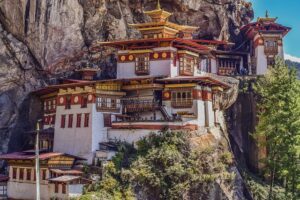
- Tiger Nest (Paro Taktsang) –Tiger’s Nest, also known as Paro Taktsang, is a Buddhist tabernacle complex located in the Paro Valley in Bhutan. The tabernacle is erected on a precipice face high above the vale bottom and is a popular sightseer destination in Bhutan.According to legend, the tabernacle was innovated in the 8th century by the Buddhist practitioner Padmasambhava, who’s said to have flown to the point on the reverse of a tigress. The tabernacle has been a place of passage for Buddhists for numerous centuries and is considered one of the holiest spots in Bhutan.The tabernacle complex consists of several structures and tabernacles erected into the precipice face, including a main tabernacle and several lower sanctuaries. Callers to Tiger’s Nest can explore the tabernacle complex, visit the sanctuaries, and take in the stirring views of the vale below. The tabernacle is a popular destination for excursionists visiting Bhutan and is a great place to learn about Bhutanese culture and Buddhism. which is the foremost reason for “How Bhutan preserve their Culture”.
- Tashichho Dzong – Tashichho Dzong is a Buddhist friary and fort located in the capital megacity of Thimphu, Bhutan. It’s one of the most important milestones in the country and serves as the seat of the country’s government and the office of the King of Bhutan. The Dzong, which was erected in the 13th century, is a beautiful illustration of Bhutanese armature, with intricate busts and oils decorating its walls. It’s also home to several tabernacles and sanctuaries, including the throne room of the King of Bhutan. The dzong is open to callers and offers a fascinating regard into Bhutanese culture and history.
- The Folk Heritage Museum – The Folk Heritage Museum, also known as the Bhutan Folk Heritage Museum, is a gallery located in Thimphu, Bhutan. The gallery was established in 2001 with the thing of conserving and promoting Bhutan’s traditional pastoral crafts, culture, and way of life. The gallery is housed in a 19th- century Bhutanese grange and is filled with shows showcasing the diurnal life and traditions of Bhutanese townies. The gallery also has a number of interactive shows that allow callers to witness Bhutanese culture firsthand. Some of the shows at the Folk Heritage Museum include a traditional Bhutanese kitchen, a blacksmith’s factory, and a embroiderer’s plant. The gallery is a popular destination for excursionists visiting Bhutan and is a great place to learn about the country’s rich artistic heritage. which is the foremost reason for How Bhutan preserve their Culture. numerous excursionists come to see it.
- Bhutan Textile Museum –The Bhutan Textile Museum is a gallery located in Thimphu, Bhutan. The gallery was established in 2001 with the thing of conserving and promoting Bhutan’s traditional cloth trades. The gallery is housed in a 19th- century Bhutanese house and is filled with shows showcasing the history and ways of Bhutanese cloth product. The gallery has a collection of over 400 fabrics, including exemplifications of Bhutanese thangkas( religious oils on fabric), traditional apparel, and ornamental fabrics. The gallery also has a number of interactive shows that allow callers to learn about the process of creating traditional Bhutanese fabrics, from spinning and dyeing the yarn to weaving the fabric. The Bhutan Textile Museum is a popular destination for excursionists visiting Bhutan and is a great place to learn about the country’s rich artistic heritage.
- Motithang Takin Preserve –Motithang Takin Preserve is a small beast sanctuary located in Motithang, Thimphu, Bhutan. The save is home to Bhutan’s public beast, the takin, which is a large, heavyset mammal with a thick fleece and a distinctive, shaggy mane. The takin is set up only in the Himalayan regions of Bhutan, India, and Nepal, and is considered an exposed species. The Motithang Takin Preserve was established in the 1970s as a place to cover and study the takin. The save is home to a small herd of takins, which are kept in a large, fended- in area. Callers to the save can observe the takins over near and learn about their natural history and geste . The save also has a number of educational shows that give information about the takin and other creatures set up in Bhutan.The Motithang Takin Preserve is a popular destination for excursionists visiting Thimphu and is a great place to learn about Bhutan’s unique natural history and culture.
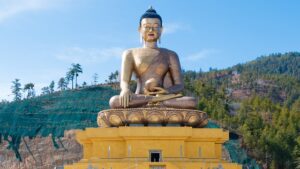
- Simply Bhutan –Simply Bhutan is a artistic and heritage center located in Thimphu, Bhutan. The center was established with the thing of promoting Bhutan’s artistic heritage and traditions and furnishing a variety of educational and interactive shows and conditioning for callers. Some of the effects to see and do at Simply Bhutan include. Traditional Bhutanese vill life exhibits Callers can explore clones of traditional Bhutanese houses and learn about the diurnal life and customs of Bhutanese townies. Cultural performances Simply Bhutan hosts regular traditional cotillion and music performances by original artists. Craft shops Callers can share in shops to learn about traditional Bhutanese crafts similar as woodcarving, papermaking, and weaving. Cultural tenures Simply Bhutan offers guided tenures of Thimphu and the girding area, which give an in- depth look at Bhutan’s culture and history.Simply Bhutan is a great destination for excursionists visiting Thimphu who are interested in learning further about Bhutanese culture and traditions.
- Rinpung Dzong – Rinpung Dzong is a Buddhist friary and fort located in Paro, Bhutan. It’s one of the largest dzongs in the country and serves as the executive center for the Paro quarter. The Dzong, which was erected in the 15th century, is a beautiful illustration of Bhutanese armature, with intricate busts and oils decorating its walls. It’s also home to several tabernacles and sanctuaries and is a popular destination for callers to Bhutan. In addition to its religious and artistic significance, Rinpung Dzong is also known for its part in the defense of Bhutan. It has been used as a military fort in the history, and its walls and halls offer stunning views of the girding vale.
- Bhutan National Museum – The Bhutan National Museum is a gallery located in Paro, Bhutan. It’s devoted to conserving and displaying the artistic heritage of Bhutan and is home to a wide range of vestiges including fabrics, masks, munitions, and religious objects. The gallery is located in Ta Dzong, a former watchtower that has been converted into a gallery. It’s girdled by beautiful auditoriums and offers stunning views of the girding vale. The Bhutan National Museum is a popular destination for callers to Bhutan and is a great place to learn about the country’s rich artistic history and traditions. which is the foremost reason for “How Bhutan preserve their Culture”.
- Chelela Pass – Chelela Pass is a high mountain pass located in Bhutan. It’s positioned at an elevation of,988 measures(,082 bases) above ocean position and is the loftiest motorable road in Bhutan. The pass is located on the way to Haa Valley, and offers stunning views of the girding mountains. It’s a popular destination for excursionists and is known for its beautiful natural decor and its rich artistic heritage. There are several tabernacles and cloisters located near the pass, which are popular lodestones for callers. The pass is generally snow- covered in the downtime months and can be relatively cold and unfaithful during this time. still, it’s a beautiful and serene place to visit during the warmer months of the time.
- Punakha Dzong – Punakha Dzong is a Buddhist friary and fort located in Punakha, Bhutan. It’s one of the most important dzongs in Bhutan and has a long and rich history. The Dzong was erected in the 17th century and served as the capital of Bhutan until 1955. It’s a beautiful illustration of Bhutanese armature, with intricate busts and oils decorating its walls. The Dzong is home to several tabernacles and sanctuaries and is an important center of Buddhist literacy. It’s also the point of the coronation of the King of Bhutan and is considered one of the most sacred places in the country. Punakha Dzong is a popular destination for excursionists and is a great place to learn about Bhutanese culture and history.
- Chimi Lakhang Temple – Chimi Lakhang Temple is a Buddhist tabernacle located in Punakha, Bhutan. It’s a popular destination for excursionists and is known for its beautiful armature and its rich artistic and spiritual significance. The tabernacle is devoted to the 15th- century Bhutanese saint, Drukpa Kunley, who’s also known as the” Divine Madman.” Kunley was known for his unconventional training and his unconventional styles of spreading the training of Buddhism. The tabernacle is located on a hilltop and offers stunning views of the girding vale. It’s a beautiful and peaceful place to visit and is an important part of Bhutan’s artistic and spiritual heritage. which is the foremost reason for How Bhutan preserve their Culture. You can come to Bhutan in numerous ways.
You can come to Bhutan in many ways.

You can reach here in two ways, by air, and by road. There is only one airport here, that too International Airport, the name of this airport is Paro International Airport. Two airlines serve here, First Druk Air and Bhutan Airlines. You can book for both these airlines through their website or through any travel agency.
If you want to come to Bhutan by road then you have to come to Jaigaon in West Bengal, here Jaigaon is the Phuentsholing border, Jaigaon is in India and Phuentsholing is in Bhutan. By crossing this border you can go to Bhutan.
To reach Jaigaon you have to come to the nearest railway station. Hasimara is the nearest railway station to Jaigaon. You can take a taxi to reach Jaigaon by getting down at Hasimara Railway Station.
Another way to reach here is if you are coming from far off then you can go to Bagdogra airport. To the north of Bagdogra airport, you can reach Jaigaon via taxi or bus. After reaching Jaigaon, you will have to reach the Fuentesoling border and enter the immigration office. After getting the entry permit, you will have to go to Thimphu. Thimphu is at a distance of 147 km from Phuntsholing. You can reach Thimphu by bus, taxi or bike.
The bus fare is 300 to 500 and if you book a taxi it may cost you 3000 to 5000 or if you want to go in a shared taxi it will cost you 700 to 800 rupees.
Tour planning
Paro, Thimphu, and Punakha are three very famous cities in Bhutan.
If you are coming by flight then you will land at Paro and you will first go to Paro then Thimphu then will go to Punakha.
If you are coming here by bike, taxi or bus then first you will reach Thimphu, then you will go to Punakha, then lastly you will go to Paro.
Day 1, Thimpu
-
- Tashichho Dzong
- Folk Heritage Museum
- Bhutan Textile Museum
- Motithang Takin Preserve
- Simply Bhutan
- Buddhist Point
- Memorial Chorten
Day 2, Paro
-
- Tiger Nest (Paro Taktsang)
- Rinpung Dzong
- Bhutan National Museum
- Chelela Pass
Day 3, Punakha
-
- Punakha Dzong
- Punakha Suspension Bridge
- Chimi Lakhang Temple
- River Rafting
You can also visit Dochula Pass, Dochula Pass is in Thimpu and Punakha
Best Time to visit Bhutan
– From September to May.
Tour Budget,
Hotel – 3000 / Day for 2 Adults
Meals – 1500 / Day for 2 Adults
Conveyance – 1500 / Day for 2 Adults
Entry Fee – 2000 for 1 Adult
Extra Entry Fee – 2000
Full expenditure of 1 Adult for 3 days – 13000 to 15000
Actual cost may vary, depending on season factor ETC excluding flight cost
I wish everyone to explore this beautiful world and learn the things to make our world a better place to live. With this, if you enjoyed reading this blog, do comment and share it with your friends and family and keep following Nomad Rahgir..

